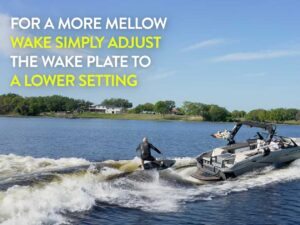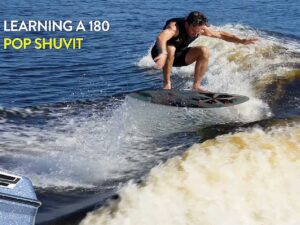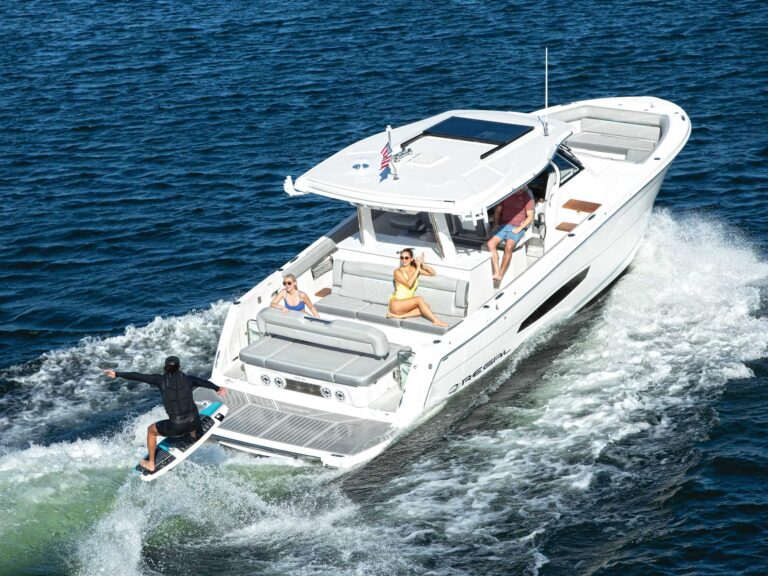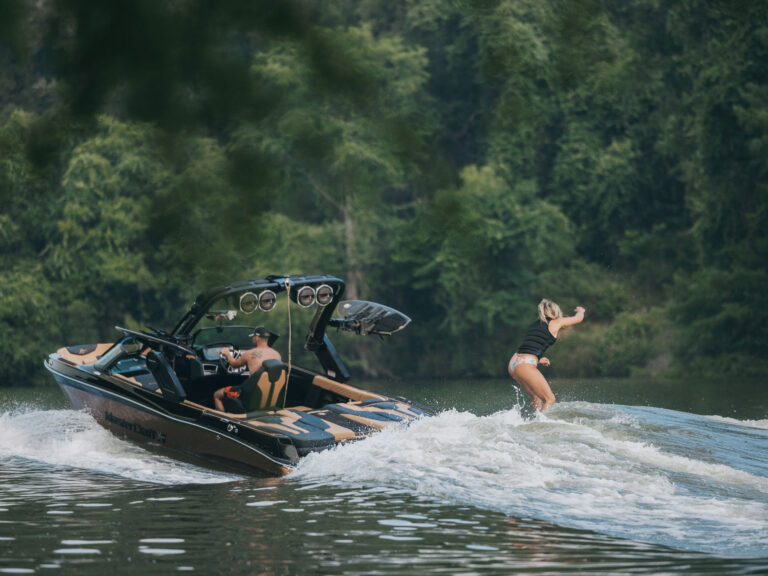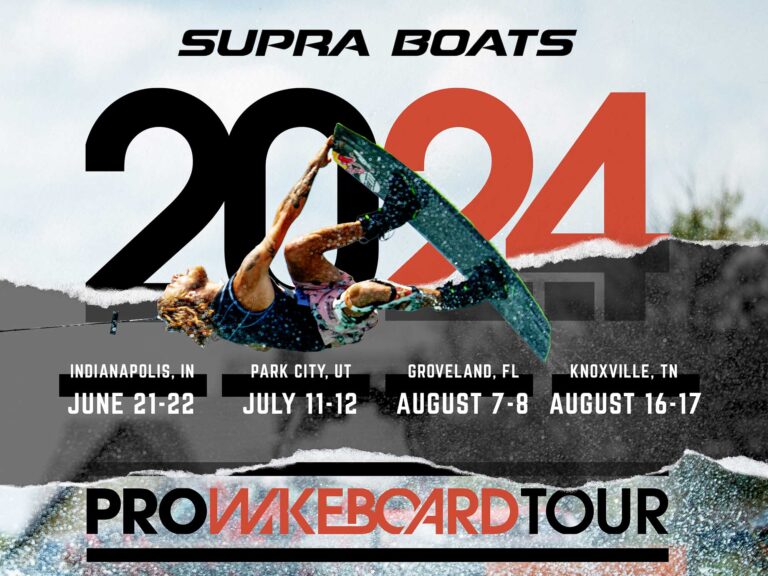Wakeboard designers must be watching a lot of TV here in 1998, particularly those car commercials that claim, “Wider is better.” Or maybe it’s the rebirth of surfing’s “fish” that has them expanding their minds, and subsequently their boards. Whatever the reason, there’s no denying that wakeboarding designs are getting fat. Hell, we could barely squeeze a few of the 1998 models through our office door. Okay, maybe that’s not entirely true, but at least a few of of them were so broad they should have come equipped with little yellow flags for each rail and a banner that says “Wide Load” across the back. The majority of 1997’s models have been widened anywhere from a hair to an inch from tip to tail.
So what is it about wide that says “ride” to everyone nowadays? Certainly the free-ride movement has had some effect on shapes. People who are more concerned with spinning and skate-style moves crave a shorter, more maneuverable piece of gear. And with more and more people getting involved each year in our sport, there’s going to be a – pardon the pun – wider variety of opinions on how a board should perform. But is wide for you? Good question, and one you should consider, taking into account the following factors.
What Wide Does
WIDTH = LIFT = POP = AIR. Looking at opposite ends of the lift spectrum, the reason water skis slice through the wake instead of getting air is because they are skinny. Their narrow width keeps them on the water even at high speeds. They produce very little lift – hell, at wakeboard speeds, they wouldn’t even be above the water. The reason broad surfboards like the fish can get air – even at low speeds (the speed you get in small, shitty waves) – is because they are so wide they provide tons of lift. These same design factors apply to wakeboards. It shapes up like this: The CWB T2 model and the O’Brien Phatty have roughly the same amount of surface area, even though the thinner T2 eyeballs out to be the bigger board. But I guarantee you that nine out of 10 average riders will get the feeling of bigger air on the Phatty. That’s because when the wider board hits the wake, there’s more surface area (width) being propelled skyward at the take-off point. That’s where you feel the power of wide. Conversely, a board like the T2 or Hyperlite’s Shapiro uses a longer surface area on the edge to create speed, which is then transferred into energy off the wake.
But very few people ride like Shapiro. He comes into the wake literally at twice the speed of the average rider. His aggressive style of charging into the wake would be hampered by a wider board because it would go significantly slower. More surface area in the water during a cut equals more resistance and less angle speed. So if you dig a wide board down at the beginning of your cut (as Shapiro does with his thinner board) you will be slowing the board down from the outset, and it’ll be hard to get a good pop off the wake.
The bottom line is lift produces air and you can get lift through speed or width. Shapiro and riders of
slightly narrower, longer boards get their lift through speed. But if you don’t think you can generate speed nearing his, you might want to consider getting your lift from board width.
The Spin Factor
So you say pop and big air aren’t what you’re looking for, huh? You want a board that’ll spin fast and easy no matter how high you go. Well, as any rotationally strong rider can attest, spins are a lot easier if you have more time in the air. Not that a wide board necessarily spins better, but a short board spins way better than a long one, and it just so happens many of the shorter boards have to be wide. The closer the bulk of a board’s weight and resistance is to the center of the board, the better it will rotate. Obviously, an 8-foot-long board would be a real bitch to spin because of its size, but one just slightly longer than your stance will spin great – width notwithstanding. The reason a short board ends up being wide is so that it can provide enough lift (surface area) to let you ride. The point is that, in many cases, width is solely a function of length. Wide boards aren’t better spinners, but short boards are.
How Wide Is Too Wide?
Jimmy Redmon designed Liquid Force’s Squirt, the first commercially available “wide” board. His initial approach with the Squirt was to make a board 10cm shorter than the shortest out there. To do that he had to make the width wider, the tips wider and the bottom shape with a lot of lift. As he was experimenting with shorter, wider boards Redmon discovered that going too wide made the board too dificult to cut. “When you lean the board over, if you have such a wide body it puts the board up on such a radical angle that the fin releases before it can drive the board down,” he explains. Redmon also found that you can take width to the point where you have to nurse your turn so much to engage the tail that riding wasn’t as fun. One final factor Redmon discussed is that as you take a board wider, you have to take it shorter as well so it doesn’t have too much surface area. However, by going too short, you have difficulty putting enough rocker into the tips to get the board over the wake. And if you do put the correct amount of rocker in a board that’s too short and wide, it has the effect of landing like a bowling ball. The board stops and you go out the front. Obviously, he found the width he felt was best and stuck with it.
So short and wide are good for both lift and spinning, but shorter and wider aren’t necessarily better. Shapiro says too wide a board tends to “buck” you on big landings. Too wide will also make landings feel a lot harder on the knees and ankles because there’s more board acting to amplify the shock of you coming down on the water.
Where to Be Wide
Once you start understanding boards you’ll talk about nose and tail width, and tip and tail rocker. If you only were concerned about how wide a board is in the center, i.e. 16.5 inches, you wouldn’t necessarily get a board that rides like a wide board. If the tips are pulled in and it has a lot of outline curve, it won’t ride like you expect and want a wide board to. Tip and tail width are critical.
Surfboards are supposedly shaped with precise detail on where the width is. Something similar applies to where the width is placed on wakeboards. Since the wake is usually always the same, the variable in this case is only the rider’s style. The Liquid Force Squirt is fairly wide through the complete outline of the board. This does two things. First, since it has a relatively straight outline, a rider has to sink the entire rail at once to get an edge. If he can do this and hold that edge through the wake, the board will work unbelievably well. Pop in a video of Gator riding the Squirt and you’ll see what I mean. Now looking at the Super Squirt, it has the same width tip and tail so it will still give the great pop for the rider who can pull through the wake, but it has a wider center so it is easier to sink a rail on the cut-you don’t have to sink the rail all at once. Then, there’s the O’Brien Phatty which is extremely wide right in the middle but less wide in the tips. This board will give the rider who doesn’t pull all the way through the wake a nice, wide section off which to pop.
You may also want to consider a board that is wide in the insert area if you have especially large feet. Having your toes drag off a thin board on a frontside cut does nothing but slow you down and hinder your ability to get air. By going wider in the middle, your toes and heels will remain over the edges and allow the board to do what it’s supposed to.
Wide as an Option
O’Brien’s Pat McElhinney suggests a wide board as a nice option for those who are having difficulty learning advanced moves, where better vertical pop will help. “When you’re learning something like an S-bend, spee
d is really at a premium, and a longer-profile board helps with that. But say you want to try mobes or other spinning flips. A short, wide board is great to learn on because it’ll take the trick up and down, rather than side to side, which benefits those kinds of moves.”
Wide boards can also help to eliminate the problem of “pearling” a thin-tipped board upon landing and taking a lot of nasty wipeouts. It’s a simple matter of physics: A wide board will displace more water side to side (and subsequently provide more stability) than a longer board of the same weight.
The Downside
Of course, going wide does have a dark side. If you ride on a body of water that is constantly choppy, you can bet a wider board is going to pick up on all those bumps and dips and make the ride seem even rougher. Matt Staker also says, “Two things that bug me about wide boards are that sometimes I have problems sinking the edges to cut hard when I need to, and they bounce on the landings. I like a little bit wider of a board, but at certain times they can work against you.” Same goes for Charley Patterson, who spent several years figuring out that he rides best with a board that measures 16 inches at its widest point. “Right now I’m riding 16, and it just feels right when I cut, especially on landings. There’s a big difference even if you add a half inch all the way through, and I need soft landings because my knees are so messed up.”the insert area if you have especially large feet. Having your toes drag off a thin board on a frontside cut does nothing but slow you down and hinder your ability to get air. By going wider in the middle, your toes and heels will remain over the edges and allow the board to do what it’s supposed to.
Wide as an Option
O’Brien’s Pat McElhinney suggests a wide board as a nice option for those who are having difficulty learning advanced moves, where better vertical pop will help. “When you’re learning something like an S-bend, speed is really at a premium, and a longer-profile board helps with that. But say you want to try mobes or other spinning flips. A short, wide board is great to learn on because it’ll take the trick up and down, rather than side to side, which benefits those kinds of moves.”
Wide boards can also help to eliminate the problem of “pearling” a thin-tipped board upon landing and taking a lot of nasty wipeouts. It’s a simple matter of physics: A wide board will displace more water side to side (and subsequently provide more stability) than a longer board of the same weight.
The Downside
Of course, going wide does have a dark side. If you ride on a body of water that is constantly choppy, you can bet a wider board is going to pick up on all those bumps and dips and make the ride seem even rougher. Matt Staker also says, “Two things that bug me about wide boards are that sometimes I have problems sinking the edges to cut hard when I need to, and they bounce on the landings. I like a little bit wider of a board, but at certain times they can work against you.” Same goes for Charley Patterson, who spent several years figuring out that he rides best with a board that measures 16 inches at its widest point. “Right now I’m riding 16, and it just feels right when I cut, especially on landings. There’s a big difference even if you add a half inch all the way through, and I need soft landings because my knees are so messed up.”
